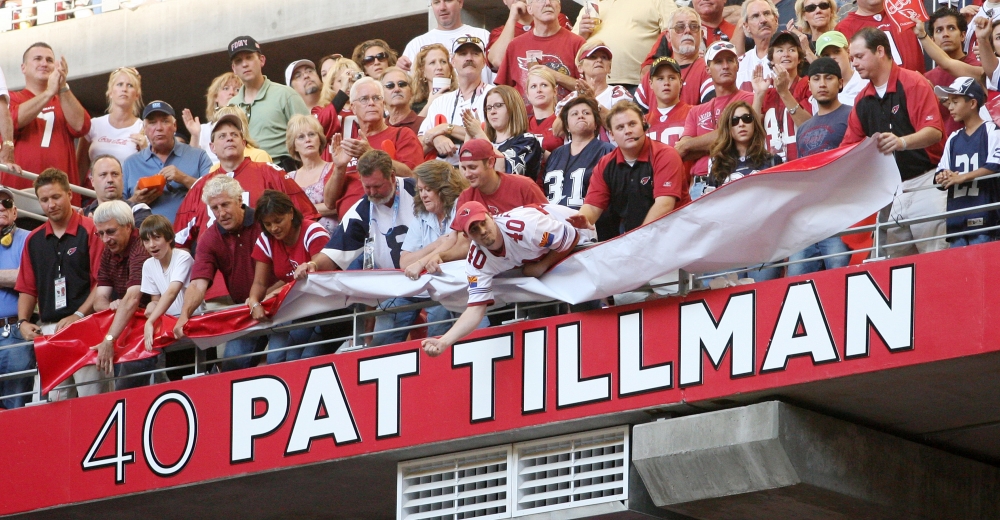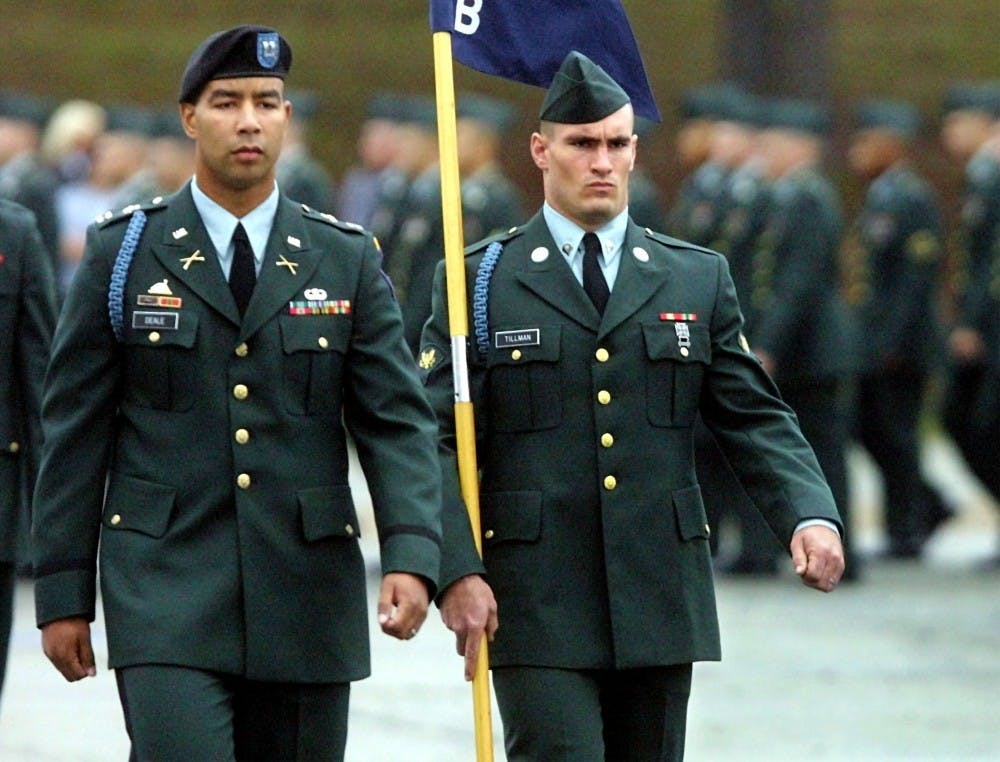Before I begin, I must concede one point: I never saw Pat Tillman play a single down on a football field by the time of his untimely death. I had hardly heard of the man by the time the news broke when I was just 6.
I associated No. 42 with Jackie Robinson before I even thought to bring up Pat Tillman.
I was born and raised in Chandler, just a short drive away from Sun Devil Stadium in Tempe, but I never had that football background. With two immigrant parents, I spent more of my time on the soccer field than out in the stands in maroon and gold.
I was an American, but not in the traditional sense. I was born here but was immersed in South American culture from birth, and frankly, didn't do most things that typical "American" families did.
When Pat Tillman was killed in action by friendly fire in Afghanistan in 2004, I thought little of it. It was an unfortunate tragedy, I thought, but I knew little of the man and the battle of what was going on around me.
I had understanding of the world going on around me, with one of my first memories being of my mother sitting me and my then-5-year-old sister down and having to explain that my country had been attacked by terrorists on Sept. 11, 2001.
But why a man would turn down millions to fight for his country still evaded me. I just did not understand.
That was, until I found out the sort of man that Pat Tillman was.
I don't think often of many teachers I've had in my youth, but my seventh and eighth grade science teacher, Mr. Hayden, is one.
I remember sitting in his class one day and having something catch my eye: a poster of Tillman.
It was the same photo that is iconically shown of him to this day — Tillman, with his football helmet off and long hair flowing while wearing No. 40 for the Arizona Cardinals.
Alongside it stood the other photo for which Tillman is remembered today, his military photo taken before he was sent off to fight for his country.
On this day in 2004, former Arizona Cardinals safety Pat Tillman was killed in Afghanistan
RIP pic.twitter.com/tI6geWjKEX
— NFL on ESPN (@ESPNNFL) April 22, 2015
This struck me as odd — Mr. Hayden had never shown much interest in football, never making a point of his allegiances to the sport. He didn't attend ASU, and had no real ties to the area before coming to teach in Arizona.
Mr. Hayden was a veteran himself, having served for the U.S. in Europe during World War II. He understood the sacrifice, unlike myself and most of the other kids in the class.
One day another student, with the same curiosity I had, asked Mr. Hayden about the poster.
Hayden then told the story of Pat, from his time at ASU to the NFL, then the decision that shocked the sports world — his decision to turn down millions in a contract extension in order to serve his country post-9/11.
I understood.
From that point on, my love for football grew.
I watched ASU regularly, and every single time I tuned in to watch the Sun Devils one thing stood out — the maroon and gold No. 42 jerseys that seemed to flood the stands at every game.
I studied Tillman often, listened to what teammates and coaches had to say about the complicated, yet free-spirited California boy who helped lead ASU to one of its most successful periods in program history.

I learned about his willingness to turn down a three-year, $3.6 million extension from the Cardinals, about his death and what followed.
Behind all the greatness that seemed to follow Tillman's honorable death also lingered a black cloud.
After hearing the great stories about Tillman for years, I found out the ugly truths in his death when I was in high school.
I was in my freshman year at Chandler High when around the sixth anniversary of his death I came across the 2005 Washington Post investigation into his death and the cover-up that followed.
I read Jon Krakauer's book "Where Men Win Glory," which shed more gory details about the U.S. Army in its attempt to hide the fact that it was friendly fire that killed one of America's idols.
I also found that Tillman was at times opposed to the war in Iraq, criticizing President Bush's policies and even going so far as to call the invasion "illegal."
For a period, I was confused by it all.
Tillman was not the stereotype many made him out to be in my eyes. He was more than that: a complicated everyman whose spirit made him special and whose talents in life and on the football field were magical.
By the time the 10-year anniversary of Tillman's death rolled around during my senior year of high school, I accepted his story.
I understood that Tillman was not perfect, the factors surrounding his death were not as heroic as he was made out to be and that his case was just like many who had come before him (besides the fact that he was in the NFL).
Tillman was not the hero I thought he was. He was more than that.
It has been commonplace to try to put athletes and celebrities into the role of being models for the next generation and for how to act in real life. Children aspired to be the next superstar, trying to mimic their actions and paths in order to make the same impact on children that they had on them.
Athletes are not heroes. Celebrities are not heroes.
Pat Tillman was a true hero.
His life was an epic in and of itself. He secured the final scholarship to make the ASU football team back in 1994, spending his college days as an example of character, hard work and commitment both on and off the field.
He was an open spirit, one who would often climb up to the light towers at Sun Devil Stadium to think and reflect.
Tillman followed his career in college by staying local and becoming a star with the Arizona Cardinals before sacrificing for his country by enlisting during one of its most trying times.
But what made Tillman heroic was also the fact that he was not perfect. The circumstances of his death, while unfortunate, only add to his heroic mystique.
Perhaps what is most telling about Tillman is the fact that we still mention him in almost every reference to the ASU football program and his legacy remains part of every day life.
There's plenty of argument to see who is on the figurative ASU football "Mt. Rushmore," but Tillman's No. 1 spot is always secure.
Pat's Run, which raises money every year to fund the education of Tillman Scholars to create the next generation of American heroes, is one of the state's most-attended events every year. Sun Devil and Wildcat fans alike run the 4.2-mile trek in order to remember one of the world's greats.
At Sun Devil Stadium, No. 42 is everywhere: the black "PT42" crest on the jersey, the Tillman Tunnel, the military row and the continuous flood of Tillman jerseys everywhere proves it.
Current Sun Devils strive for the highest accomplishment in practice — the honor of wearing the camouflage No. 42 Tillman jersey.

Like those who played with him, the name Tillman comes out of nearly every Sun Devil's mouth when asked about the expectations of the program and of them as men.
"(Pat Tillman) represents the way we play, the way we live our life as a football player here," ASU senior wide receiver D.J. Foster said. "We have that name with us. If you're an ASU student athlete, an ASU football player, you try to represent yourself with class on and off the field."
"It's an unbelievable honor just to have that jersey," ASU redshirt senior safety Jordan Simone said. "What that jersey stands for: character, discipline and being smart. Everything in the community, on the field and in the classroom is what that jersey stands for."
"That's all coach (Todd) Graham talks about," redshirt sophomore wide receiver Ellis Jefferson said. "When I was on my recruiting trip, when I got here all they were talking about was Pat Tillman, about how he gave back. When I walk into the building, all I see is Pat Tillman."
Eleven years after his death, there have been several ways people have talked about and said they will remember Tillman.
The way I remember Pat Tillman can be put into one word — hero.
Reach the assistant sports editor at fardaya@asu.edu or follow @fardaya15 on Twitter.
Like State Press Sports on Facebook and follow @statepresssport on Twitter.




